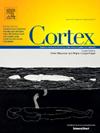面孔感知中全局/局部偏见的神经生理标记
IF 3.3
2区 心理学
Q1 BEHAVIORAL SCIENCES
引用次数: 0
摘要
在结构复杂刺激的视觉处理过程中,整体/局部偏差发生在观察者的特定条件下。先前使用分层字母(由小字母组成的大字母)的实验报告称,这种现象在年轻人中普遍存在。在这里,我们旨在定义在新面孔内隐加工过程中可能的全局/局部偏见的神经生理标记。我们对年轻人进行了两个ERP实验,使用分层/复合面部刺激,一种是一致的(眼睛被小脸取代),另一种是不一致的(物体作为眼睛),外围小物体和人脸分别被移植作为分心物。在实验1中,脸部敏感的N170/VPP在规则面孔中最大,在一致和不一致的等级面孔中逐渐降低,证明了整体偏见的破坏。在实验2中,N170/VPP在分层人脸和新对象条件下是相似的,可能是由于为了防止全局偏差而增加了视角。此外,在两个实验中都出现了对不一致面孔和物体的最大振幅N200-350,表明与标准面孔模板的感知不匹配。实验2还揭示了对物体和面部的后验负性~ 220-330 msec,可能表明对已知类别的访问,以及对象特定的后期正性,可以反映对常见物体的前语义视觉识别。源重建强调了腹侧(主要是右侧)视觉区域在这些ERP调制中的重要参与。该实验设计可用于检测与个体差异和神经退行性疾病相关的全局/局部偏见和面部和物体处理的几个标记,甚至在它们明显表现之前。本文章由计算机程序翻译,如有差异,请以英文原文为准。
Neurophysiological markers of the global/local biases in face perception
Global/local biases in the visual processing of structurally complex stimuli occur under certain conditions of the beholder. Previous experiments using hierarchical letters (large letters made of small ones) have reported a global precedence in young adults. Here, we aimed to define neurophysiological markers of a possible global/local bias during the implicit processing of new faces. We performed two ERP experiments on young adults using hierarchical/compound facial stimuli, either congruent (eyes replaced by small faces) or incongruent (objects as eyes), with peripheral small objects and faces, respectively, grafted as distracters. In Experiment 1, the face-sensitive N170/VPP was largest for regular faces and progressively decreased through congruent and incongruent hierarchical faces, evidencing disruption of the global bias. In Experiment 2, N170/VPP was similar between both hierarchical faces and a new objects condition, likely due to the visual angle increase used to prevent a global bias. Moreover, an N200-350 with maximal amplitude for incongruent faces and objects appeared in both experiments, suggesting a perceptive mismatch with a canonical face template. Experiment 2 also revealed a posterior negativity ∼220–330 msec for objects and faces, likely indicating access to known categories, as well as an object-specific late positivity that could reflect pre-semantic, visual recognition of common objects. Source reconstruction highlighted the significant involvement of ventral (predominantly right-sided) visual regions in these ERP modulations. This experimental design can be useful to detect global/local biases and several markers of face and object processing related to individual differences and neurodegenerative diseases even before they manifest overtly.
求助全文
通过发布文献求助,成功后即可免费获取论文全文。
去求助
来源期刊

Cortex
医学-行为科学
CiteScore
7.00
自引率
5.60%
发文量
250
审稿时长
74 days
期刊介绍:
CORTEX is an international journal devoted to the study of cognition and of the relationship between the nervous system and mental processes, particularly as these are reflected in the behaviour of patients with acquired brain lesions, normal volunteers, children with typical and atypical development, and in the activation of brain regions and systems as recorded by functional neuroimaging techniques. It was founded in 1964 by Ennio De Renzi.
 求助内容:
求助内容: 应助结果提醒方式:
应助结果提醒方式:


